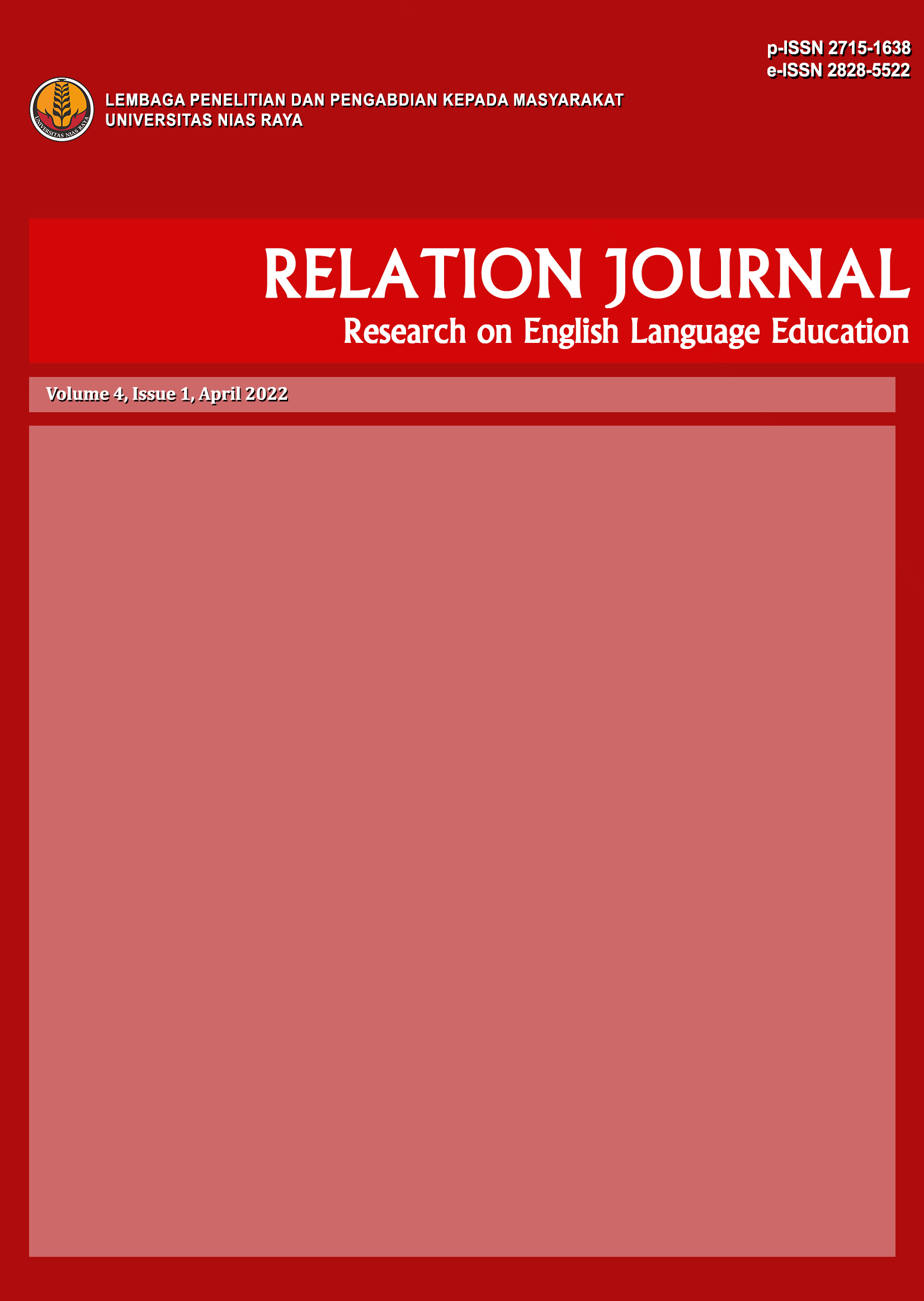IMPROVING STUDENTS’ VOCABULARY MASTERY ON NARRATIVE TEXT THROUGH MNEMONIC METHOD AT THE SEVENTH GRADE OF SMP 1 HURUNA
Abstract
This research was motivated by the researcher found many students still lack of vocabulary and difficult to memorize vocabulary. This research aimed to improving the students’ vocabulary mastery through Mnemonic Method at the Seventh Grade of SMP Negeri 1 Huruna.The research was designed in classroom action research (CAR). Observation paper of the researchers’ activities and students’ activities, and test were used as the instrument to collect the data needed. The research did action research in two cycles. Each cycle consisted of two meetings. The result of this action research was that the percentage of researchers done activities in meeting I of cycle I was 73 %, meanwhile in meeting II of cycle I was 83 %. Next, the percentage of students’ done activities in meeting I of cycle I was 69.9 %, meanwhile in meeting II of cycle I was 87.2 %. The average of students’ score in cycle I was 67.3. Furthemore, the percentage of researchers done activites in meeting I of cycle II was 93 %, meanwhile in meeting II in cycle II was 100 %. Next, the percentage of the students’ done activities in meeting I of cycle II 93.6 %, meanwhile in meeting II of cycle II was 94.8 %. The average students’ score in cycle II was 88.1. It was concluded that there was improvement of students’ vocabulary through Mnemonic method. Therefore, the researcher gives suggestion to English teachers to use Mnemonic method in teaching and learning process, because through Mnemonic method the classroom atmosphere becoming live and no boredom in learning English
References
Angkaberita.id, 23th February 2021.Bahasa di Dunia: Benua ASIA Terbanyak, Indonesia DuaBesar Di Dunia.https://angkaberita.id/2019/10/11/bahasa-di-dunia-benua-asia-terbanyak-indonesia-dua-besar-dunia/
Auerbach, C. F. & Silverstein, L. B. 2003.Qualitative Data: An Introduction to Coding and Analysis. New York: New York University Press.
Ary et al. 2010.Introduction to Research in Education (Nineth Edition).Canada: Thompson Wadsworth.
Baker, Colin. (2001). Foundation of Bilingual Education and Bilingualism(Third Edition). Canada: Biddles.
Fishman, J. A. (1972). The Sociology of Language . Cambridge: Newbury.
Hamers J.F. & Blanc M.H.A. (2004).Bilinguality and Bilingualism (Second edition).Cambridge : Cambridge University Press.
Holmes, J. 2013.An Introduction to Sociolinguistics (Fourth Edition).New York: Rouledge.
Lincoln, Y.S. &Guba E.G. 2013. The constructivist Credo. California: Left Coast Press, Inc.
Loveday, Leo. (1986). The Sociolinguistics of Learning and Using a Non-native Language. Oxford: Pergamon Press Ltd.
Miles, M.B. &Huberman, A.M &Saldaña J. 2014.Qualitative Data Analysis: An Expanded Sourcebook (Third Edition). California: SAGE publications, Inc.
Muysken, P. 2000. Bilingual Speech: A Typology of Code-Mixing.Cambridge: United Kingdom at the University Press.
Richards, Jack. (2010). Longman: Dictionary Language Teaching and Applied Linguistics. UK: Longman Group.
Saleh, S.A. 2017. An Analysis of Code Mixing Used by Teachers of Zarindah House of Learning in The Teaching Learning Process. Published Thesis. Makassar: Alauddin State Islamic University Makassar.
Sapir, E. 1921.Language: An Introduction to the Study of Speech. New York: Harcout, Brace and Company.
Wardaugh, Ronald. (2006). An Introduction to Sociolinguistic(fifth Edition). Oxford: Basil Black Well.
Wardaugh, R & Fuller, M.J. (2015).An Introduction to Sociolinguistic(Seventh Edition). Oxford: Basil Black Well
You are free to:
- Share — copy and redistribute the material in any medium or format for any purpose, even commercially.
- Adapt — remix, transform, and build upon the material for any purpose, even commercially.
- The licensor cannot revoke these freedoms as long as you follow the license terms.
Under the following terms:
- Attribution - You must give appropriate credit , provide a link to the license, and indicate if changes were made . You may do so in any reasonable manner, but not in any way that suggests the licensor endorses you or your use.
- No additional restrictions - You may not apply legal terms or technological measures that legally restrict others from doing anything the license permits.
Notices:
- You do not have to comply with the license for elements of the material in the public domain or where your use is permitted by an applicable exception or limitation.
- No warranties are given. The license may not give you all of the permissions necessary for your intended use. For example, other rights such as publicity, privacy, or moral rights may limit how you use the material.









